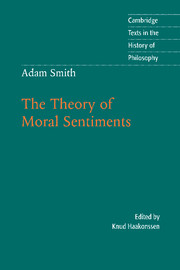Book contents
- Frontmatter
- Contents
- Introduction
- Chronology
- Further reading
- Note on the text
- Abbreviations
- The Theory of Moral Sentiments
- Advertisement
- Contents
- Part I Of the propriety of action
- Part II Of merit and demerit; or, of the objects of reward and punishment
- Part III Of the foundation of our judgments concerning our own sentiments and conduct, and of the sense of duty
- Part IV Of the effect of utility upon the sentiment of approbation
- Part V Of the influence of custom and fashion upon the sentiments of moral approbation and disapprobation
- Part VI Of the character of virtue
- Part VII Of systems of moral philosophy
- Index
- Cambridge texts in the history of philosophy
Part V - Of the influence of custom and fashion upon the sentiments of moral approbation and disapprobation
Published online by Cambridge University Press: 05 June 2012
- Frontmatter
- Contents
- Introduction
- Chronology
- Further reading
- Note on the text
- Abbreviations
- The Theory of Moral Sentiments
- Advertisement
- Contents
- Part I Of the propriety of action
- Part II Of merit and demerit; or, of the objects of reward and punishment
- Part III Of the foundation of our judgments concerning our own sentiments and conduct, and of the sense of duty
- Part IV Of the effect of utility upon the sentiment of approbation
- Part V Of the influence of custom and fashion upon the sentiments of moral approbation and disapprobation
- Part VI Of the character of virtue
- Part VII Of systems of moral philosophy
- Index
- Cambridge texts in the history of philosophy
Summary
Of the influence of custom and fashion upon our notions of beauty and deformity
1 There are other principles besides those already enumerated, which have a considerable influence upon the moral sentiments of mankind, and are the chief causes of the many irregular and discordant opinions which prevail in different ages and nations concerning what is blameable or praise-worthy. These principles are custom and fashion, principles which extend their dominion over our judgments concerning beauty of every kind.
2 When two objects have frequently been seen together, the imagination acquires a habit of passing easily from the one to the other. If the first appear, we lay our account that the second is to follow. Of their own accord they put us in mind of one another, and the attention glides easily along them. Though, independent of custom, there should be no real beauty in their union, yet when custom has thus connected them together, we feel an impropriety in their separation. The one we think is awkward when it appears without its usual companion. We miss something which we expected to find, and the habitual arrangement of our ideas is disturbed by the disappointment. A suit of clothes, for example, seems to want something if they are without the most insignificant ornament which usually accompanies them, and we find a meanness or awkwardness in the absence even of a haunch button. When there is any natural propriety in the union, custom increases our sense of it, and makes a different arrangement appear still more disagreeable than it would otherwise seem to be.
- Type
- Chapter
- Information
- Adam Smith: The Theory of Moral Sentiments , pp. 227 - 247Publisher: Cambridge University PressPrint publication year: 2002

